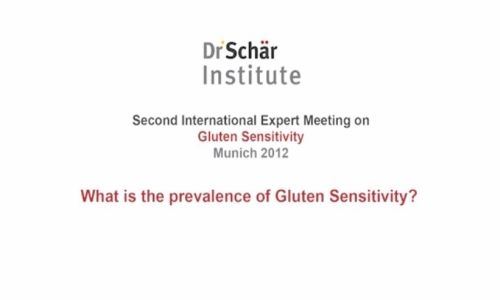Prevalence of non-coeliac gluten sensitivity

Estimated prevalence of non-coeliac gluten sensitivity (NCGS) varies between 1% and 13% of the population, and as such may be higher than the prevalence of coeliac disease. Unreported cases are likely to be at a similarly high level to coeliac disease [1].
Research indicates that NCGS is probably more prevalent than coeliac disease. Until now, however, there has been a lack of extensive epidemiological studies to verify estimated prevalence of this condition. Clinic data from the Center for Celiac Research, University of Maryland, showed that 6% of the 9,000 patients treated there between 2004-2010 met the criteria for NCGS and complained of corresponding symptoms, without having coeliac disease or wheat allergy [2]. In a recent UK study 13% of a general population sample reported symptoms attributed to gluten [3].
Outcome of the consensus conference on gluten-related disorders
References
- Aziz I, Hadjivassiliou M, Sanders DS.The spectrum of noncoeliac gluten sensitivity. Nat Rev Gastroenterol Hepatol. 2015 Epub ahead of print
- Sapone A, Bai JC, Ciacci C et al. Spectrum of gluten-related disorders: consensus on new nomenclature and classification. BMC Med 2012; 10: 13.
- Aziz, I. et al. A UK study assessing the population prevalence of self-reported gluten sensitivity and referral characteristics to secondary care. Eur. J. Gastroenterol. Hepatol. 26, 33–39 (2014).
Further information on this topic
Studies
1
Show all
Expert interviews
1
Show all

Systematic review: non coeliac gluten sensitivity
Background
Non coeliac gluten sensitivity (NCGS) is a controversial emerging disorder. Despite reported symptoms related to the ingestion of gluten, NCGS remains a diagnosis based on the exclusion of coeliac disease, given the absence of reliable biomarkers.
Aim
To evaluate the prevalence, diagnostic exclusion of coeliac disease and the efficacy of a gluten-free diet (GFD) for NCGS patients.
Methods
A PubMed search was performed up to December 2014. According to consensus diagnostic criteria, NCGS was defined as self-reported gluten intolerance, negative coeliac serology and absence of villous atrophy. Studies evaluating the impact of a GFD on patients with irritable bowel syndrome (IBS) were also included.
Results
Prevalence rates of NCGS (0.5–13%) differed widely. Seventeen studies, including 1561 patients (26 children), met the inclusion criteria for NCGS. HLA haplotypes could not be linked to histology [normal or lymphocytic enteritis (LE)] in 1123 NCGS patients. HLADQ2/DQ8 haplotypes were present in 44% of NCGS patients. After advanced diagnostic techniques in 189 NCGS patients combining LE and HLADQ2/DQ8 haplotypes, 39 (20%) were reclassified as coeliac disease. There was a higher than expected family history of coeliac disease and autoimmune disorders in NCGS patients. A GFD resulted in variable results for variable, but significantly improved stool frequency in HLADQ2 positive diarrhoea-predominant IBS patients.
Conclusions
Prevalence rates for NCGS are extremely variable. A subset of NCGS patients might belong in the so-called ‘coeliac-lite’ disease. The benefit of a GFD for NCGS patients is currently controversial. HLADQ2 positive diarrhoea- type IBS patients might gain symptom improvement from a GFD.
Resource: Aliment Pharmacol Ther. 2015 May;41(9):807-20. doi: 10.1111/apt.13155. Epub 2015 Mar 6.
Molina-Infante J, Santolaria S, Sanders DS, Fernández-Bañares F.
Non coeliac gluten sensitivity (NCGS) is a controversial emerging disorder. Despite reported symptoms related to the ingestion of gluten, NCGS remains a diagnosis based on the exclusion of coeliac disease, given the absence of reliable biomarkers.
Aim
To evaluate the prevalence, diagnostic exclusion of coeliac disease and the efficacy of a gluten-free diet (GFD) for NCGS patients.
Methods
A PubMed search was performed up to December 2014. According to consensus diagnostic criteria, NCGS was defined as self-reported gluten intolerance, negative coeliac serology and absence of villous atrophy. Studies evaluating the impact of a GFD on patients with irritable bowel syndrome (IBS) were also included.
Results
Prevalence rates of NCGS (0.5–13%) differed widely. Seventeen studies, including 1561 patients (26 children), met the inclusion criteria for NCGS. HLA haplotypes could not be linked to histology [normal or lymphocytic enteritis (LE)] in 1123 NCGS patients. HLADQ2/DQ8 haplotypes were present in 44% of NCGS patients. After advanced diagnostic techniques in 189 NCGS patients combining LE and HLADQ2/DQ8 haplotypes, 39 (20%) were reclassified as coeliac disease. There was a higher than expected family history of coeliac disease and autoimmune disorders in NCGS patients. A GFD resulted in variable results for variable, but significantly improved stool frequency in HLADQ2 positive diarrhoea-predominant IBS patients.
Conclusions
Prevalence rates for NCGS are extremely variable. A subset of NCGS patients might belong in the so-called ‘coeliac-lite’ disease. The benefit of a GFD for NCGS patients is currently controversial. HLADQ2 positive diarrhoea- type IBS patients might gain symptom improvement from a GFD.
Resource: Aliment Pharmacol Ther. 2015 May;41(9):807-20. doi: 10.1111/apt.13155. Epub 2015 Mar 6.
Molina-Infante J, Santolaria S, Sanders DS, Fernández-Bañares F.

Systematic review: non coeliac gluten sensitivity
Background
Non coeliac gluten sensitivity (NCGS) is a controversial e...
What is the prevalence of Gluten Sensitivity?
International Expert Meeting on Gluten Sensitivity 2012 in Munich, Germany

What is the prevalence of Gluten Sensitivity?
International Expert Meeting on Gluten Sensitivity 2012 in Munich, Ger...
www.drschaer-institute.com
